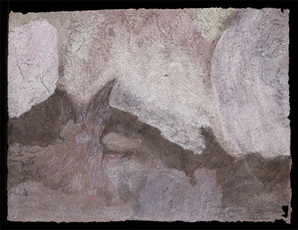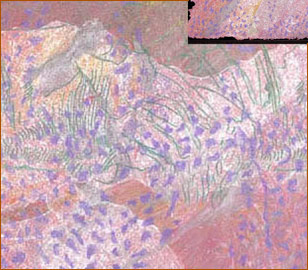 |
|
 |
Lois James:
Fine Line Stencils and Pulp Painting
By Catherine Nash
first published in the Friends of Dard Hunter’s Bull & Branch, 1997
|
I am always excited to absorb new papermaking information in any form and was quite eager to observe Lois James creating pulp paintings using mylar stencils that had been melted with tiny tipped stencil burners. Even if I hadn’t been assigned to report on her presentation I would have still been taking avid notes!

Lois James, Cavern, detail at left 17” x 22”, cotton/abaca pulp painting on cotton/abaca handmade paper base sheet, pigment, color pencil, waxed surface, 2006. |
Using a stencil burner, Lois demonstrated how to burn fine lines into mylar or poly film (.002” - .005” thick). The design is taped under a piece of glass and a piece of mylar laid on top of the glass. Desired parts are burned into the mylar. She prefers a thicker tip burner (such as what is available from JoAnn Fabric stores) so as to make a wide enough line for the paper pulp to be painted through. The burner can also be tipped on its side to achieve a little wider line or used to cut larger shapes out as well. Lois gives credit to
artist Rick Hungerford
for the beating variations in needed pulps for this pulp painting technique. Her preferred pulps of choice are 50% cotton cheny half stuff/50% abaca or 100% abaca. Using a pulp that was 1/2 hour beaten, 20 minute hydrated (meaning lift the roll or lower the bed plate whichever your machine does and for another 20 minutes continue to process the pulp) and with some formation aid in the vat, a fresh base sheet of paper is pulled, couched and left to rest for 10 minutes. If necessary, the surface is tightened up using pellon and light pressure with a brayer but not hydraulically pressed as yet.
Desired pigments are added to small amounts of very fine, overbeaten pulp (4 hours beaten and 12 hours hydrated) and then combined with formation aid. The burned stencils are placed over the base sheet and a soft brush is used to brush the pigmented pulps through the fine lines and shapes of the stencils.
| Lois also demonstrated using an atomizer (available from Colophon Book Arts) to blow pigmented pulp (with no formation aid) onto the surface. Highly diluted interference paints can be painted over an area as a wash as well. When the image is complete, the sheet is pressed and dried under strong restraint within a dry box or a drymount press. Because of the high shrinkage pulp, strong restraint is necessary for a flat sheet! |  |
|
 |
 |
| Lois James, Red Sea pulp painted handmade paper16 1/2 X 22 in. |
James writes: “Since I use stencils, and many of them are very tiny lines, the pulp has to be short-fibered. If it isn’t, it catches on the edges of the stencil. My painting pulp looks like watercolor
paint, so it is very short and very dispersed. After I beat it, I take small amounts, put it in baggies or small containers and pigment it. I then take even smaller pigmented amounts and put it in |
more water and add a dribble of formation aid until the fibers are very dispersed in the container. If there is too much pulp to water or not enough formation aid, the pulp will glob up and not flow for paint- ing. It is difficult to be more precise with my description, because some of this is instinctive when you see the pulp doing what you want it to do. My overbeaten painting pulp lasts forever because it really takes a very little bit of each color to doing my painting. (To illustrate how little I use at one time, I put the painting pulp in those little Chinese sauce cups with the lids.”
I was intrigued with the delicate line work this technique allows one to achieve as well as the subtleties of overlapping shapes and colors. Thanks to Lois for great inspiration!
Bio
Lois James has been working as a mixed media, fiber and paper artist for over 30 years. With a background in textiles, she has worked in a textile testing lab, produced and sold a line of hand- woven clothing and accessories, and indulged her passion for handmade paper. James has taught workshops and classes in the areas of papermaking, fibers, and mixed media. Living near Port Townsend, Washington, she continues to work from her private studio, taking inspiration from the surrounding seas and woods. Contact her at
loisjamespaper.com
|
|
All Rights Reserved — use of images/text by written permission of the artist only © Nash/Renfrow Productions
|
|
 |
|

